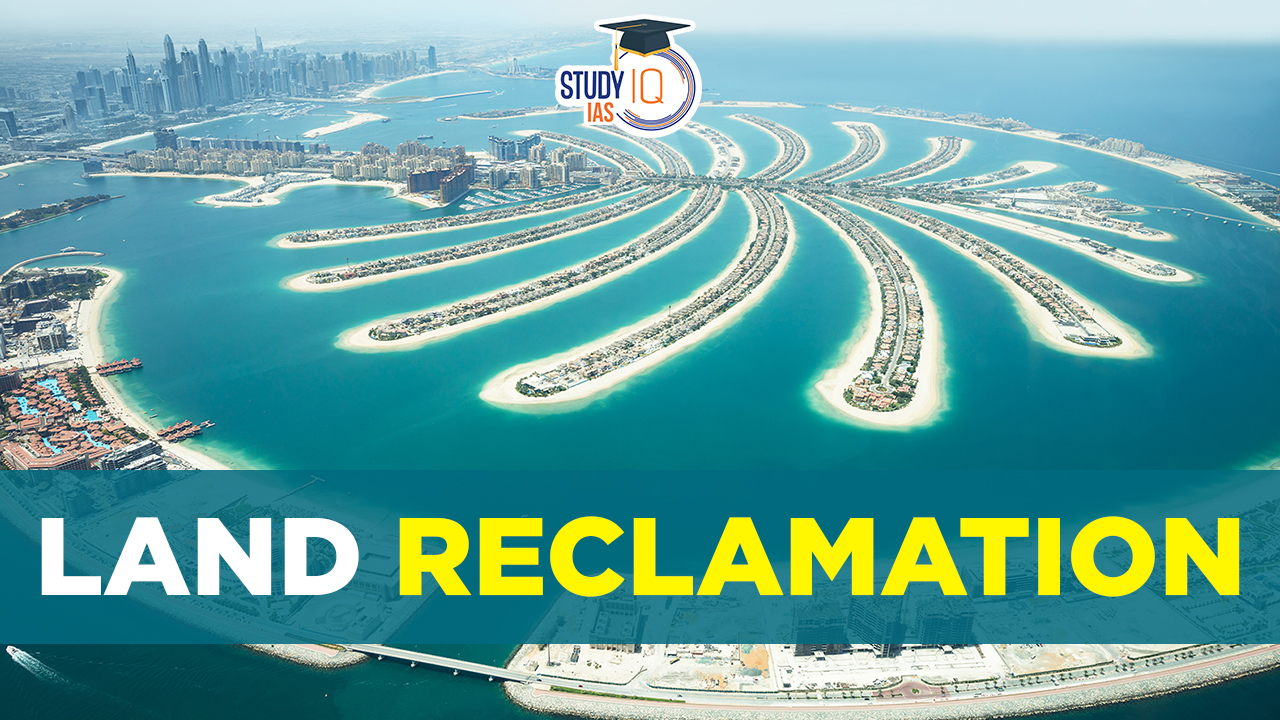Table of Contents
Context: Many places around the world have undertaken coastal land reclamation projects, intended to drain the water and use the land for multiple purposes.
What is Land Reclamation?
- Land reclamation is the process of developing new land from oceans, seas, riverbeds or lake beds. In the current context, it refers to extending land into previously submerged areas.
- Purpose of land reclamation:
- Coastal economic zones: In the developing world, the increased economic importance of coastal zones has generated a rush to claim new coastal land for luxury residential, upscale commercial and industrial space.
- Infrastructure: Land is reclaimed from sea for the purpose of building infrastructure such as roads, bridges, ports etc.
- Agriculture: In many parts of Netherlands, land reclamation allowed practice of agriculture. In absence of land reclamation practices, the land would have been flooded.
- Aquaculture: The original submerged area could be divided and barricaded to create individual ponds, which serve as a place for practicing aquaculture.
- Artificial islands: In cities such as Dubai, artificial islands have been created through land reclamation.
- Restoring original beaches: Beaches suffering due to coastal erosion can be repaired through land reclamation practices.
Land Reclamation Status Across The World
- Studies have shown that reclamation projects in 106 cities around the world had altogether created around 2,530 square kilometers of coastal land.
- About 90% of new land was created in East Asia, mostly for the purpose of industry and port facilities catering to the globalized economy.
- Between 2000 and 2020, Shanghai alone added around 350 square kilometers of new land, with Singapore and Incheon (South Korea) also raising vast new areas.
Different methods of Land Reclamation
- Artificial enclosure: Land reclamation is traditionally carried out by building a series of dikes to enclose tidal marshes or shallow offshore waters and draining these enclosures to create dry land.
- Dumping excavated material: Soil and stone could also be excavated from the mainland and dumped along the shore, gradually expanding the land into the sea.
- Diverting streams: Streams carrying additional sediment can be diverted into these areas, building up the land to a higher level.
- Artificial pumping: In case the intended coastal land was below sea level, water has to be pumped out through sluices and discharged into the sea.
Advantages of Land Reclamation
- No existing restrictions: Newly reclaimed land allows urban planners to design urban spaces from scratch, without having to worry about relocation or compensation of existing residents.
- Creating buffer zones: Land can be reclaimed to create buffer zones that prevent populated areas of the city/town. This buffer zone can include mangroves or marshes that perform ecological functions.
- Protection of vulnerable species: Plants and animals facing the threat of sea level rise can be protected through land reclamation. This is particularly applicable in low lying areas.
- Groundwater recharge: Land reclamation may result in increase of fresh groundwater resource because the reclaimed land can be an additional groundwater sink.
Concerns associated with Land Reclamation
- Risk of flooding: Land reclamation projects do not take into account the risk posed by rising sea levels, as a result of climate change.
- Storm surges: As climate change is intensifying, the risk posed by disasters is increasing. Storms have been witnessed in previously unaffected areas.
- Destruction of coastal ecosystems: Land reclamation projects have previously destroyed coastal ecosystems such as coral reefs, mangroves, marshes and wetlands. This is mainly due to suspended sediments in coastal waters.
- Illegal mining: In order to fill the reclaimed land, large amount of soil and other materials are required. These materials are being obtained through illegal mining in forested areas.
- Destroy ocean ecosystem: In order to reclaim land, many companies are resorting to extraction of sand from ocean floor. This practice is destroying ocean ecosystems.
- Land subsidence: Reclaimed lands are vulnerable to land subsidence during events such as earthquakes. This threatens the lives and properties of residents.
Way Forward
- Coastal land reclamation is a costly engineering practice that has the potential to disrupt local communities and livelihoods permanently.
- Despite all the concerns and challenges, the practice will continue as it provides a solution for many countries around the world to address its more pressing needs for increased development and urbanization.
- Countries are already spending large amounts of money to include “future-ready” reclamation techniques as well as reinforcing and elevating existing coastal defenses.
- However, the best solution in the current scenario would be to use demolished construction waste for land reclamation.


 DRDO and Air Force Successfully Test Ind...
DRDO and Air Force Successfully Test Ind...
 IB ACIO Recruitment 2025 Notification Ou...
IB ACIO Recruitment 2025 Notification Ou...





















